Stakeholder Engagement Report: Cloud Email Implementation at UniSA
VerifiedAdded on 2022/12/20
|12
|2430
|52
Report
AI Summary
This report, prepared for the University of South Australia (UniSA), addresses the critical need for stakeholder engagement in the implementation of a cloud-based email system. The report begins with an executive summary highlighting the benefits of stakeholder management, followed by an introduction emphasizing the importance of cloud-based email for UniSA's business functions. It analyzes the current IT environment, identifies key stakeholders (students, staff, alumni, shareholders, researchers), and conducts a change impact analysis. The report further details stakeholder relationships, risk analysis, and proposes a communication plan and governance framework. Vendor analysis and strategies for stakeholder engagement, including identification, analysis, consultation, feedback, and consolidation, are also provided. The report concludes with recommendations, including training, an information center, an IT team, and cybersecurity measures, and outlines an action plan for a six-month implementation timeline. References to supporting literature are included.

Running Head: Stakeholder Engagement 0
Stakeholder Engagement
Report
Student name
Stakeholder Engagement
Report
Student name
Paraphrase This Document
Need a fresh take? Get an instant paraphrase of this document with our AI Paraphraser

Stakeholder Engagement 1
An executive summary
Stakeholder management is necessary for the growth and success of the university. In
addition, it provides many benefits to the university in terms of cost and time. The cloud
provided email system will take 6 to 10 months in implementation and it requires huge
cost in all the processes. Therefore, it is necessary to find benefits of the
implementation process of a cloud-based email system in the university based on
stakeholder management. It gives a brief idea about its benefits in long terms.
This report will provide analysis of the current environment, the impact of change,
identification of stakeholders, change impact analysis, risk analysis, communication
plan, governance framework, and vendor analysis for the university.
An executive summary
Stakeholder management is necessary for the growth and success of the university. In
addition, it provides many benefits to the university in terms of cost and time. The cloud
provided email system will take 6 to 10 months in implementation and it requires huge
cost in all the processes. Therefore, it is necessary to find benefits of the
implementation process of a cloud-based email system in the university based on
stakeholder management. It gives a brief idea about its benefits in long terms.
This report will provide analysis of the current environment, the impact of change,
identification of stakeholders, change impact analysis, risk analysis, communication
plan, governance framework, and vendor analysis for the university.

Stakeholder Engagement 2
Table of Contents
An executive summary......................................................................................................1
An introduction...................................................................................................................3
The current environment of the university.........................................................................3
Stakeholder identification...................................................................................................3
Change impact analysis.....................................................................................................4
Stakeholder relationship and risk analysis........................................................................4
Communication plan..........................................................................................................5
Proposed governance framework......................................................................................5
Vendor analysis.................................................................................................................5
Strategies for stakeholders engagement...........................................................................6
Conclusion.........................................................................................................................8
Recommendation...............................................................................................................8
Action Plan.........................................................................................................................8
References.........................................................................................................................9
Table of Contents
An executive summary......................................................................................................1
An introduction...................................................................................................................3
The current environment of the university.........................................................................3
Stakeholder identification...................................................................................................3
Change impact analysis.....................................................................................................4
Stakeholder relationship and risk analysis........................................................................4
Communication plan..........................................................................................................5
Proposed governance framework......................................................................................5
Vendor analysis.................................................................................................................5
Strategies for stakeholders engagement...........................................................................6
Conclusion.........................................................................................................................8
Recommendation...............................................................................................................8
Action Plan.........................................................................................................................8
References.........................................................................................................................9
⊘ This is a preview!⊘
Do you want full access?
Subscribe today to unlock all pages.

Trusted by 1+ million students worldwide
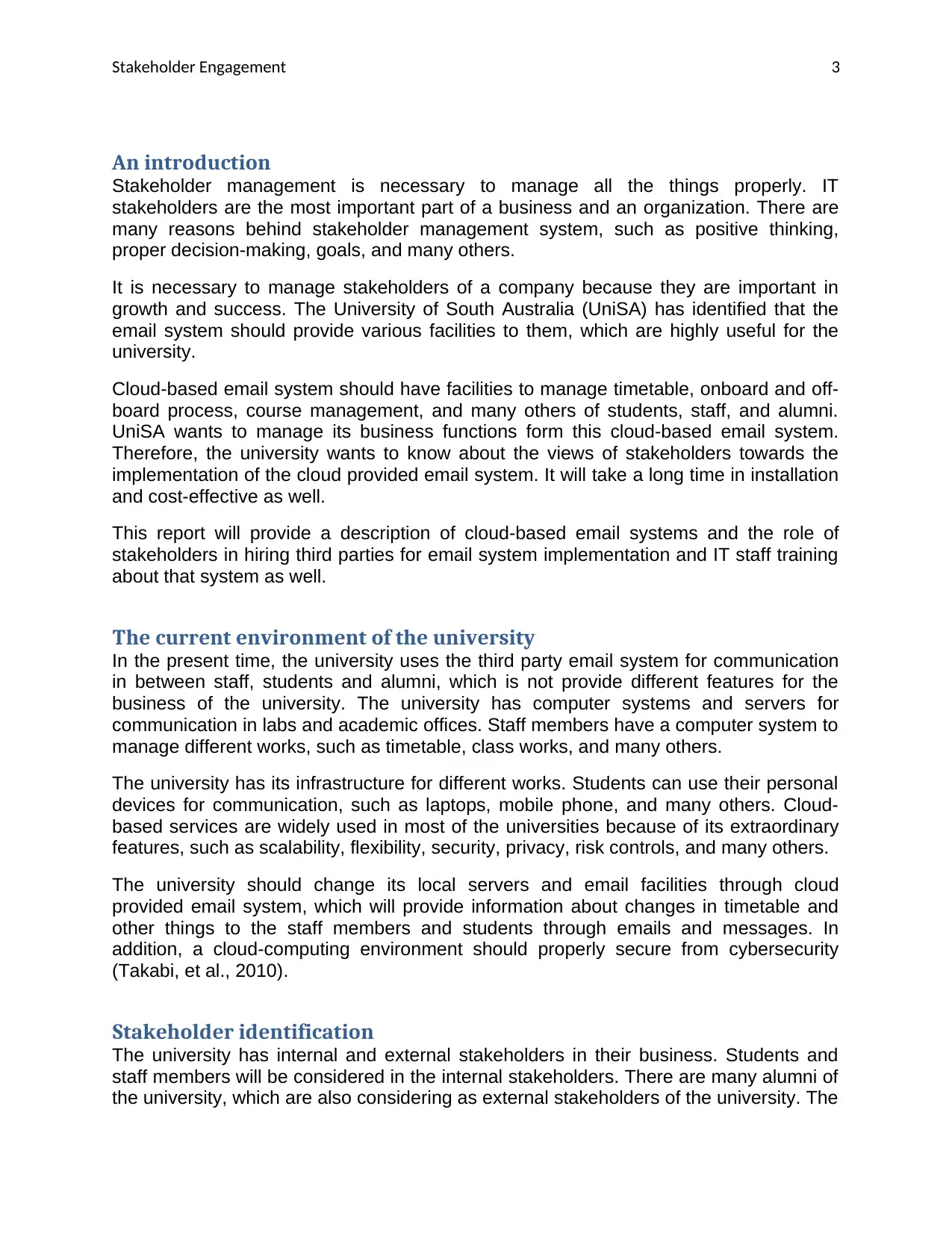
Stakeholder Engagement 3
An introduction
Stakeholder management is necessary to manage all the things properly. IT
stakeholders are the most important part of a business and an organization. There are
many reasons behind stakeholder management system, such as positive thinking,
proper decision-making, goals, and many others.
It is necessary to manage stakeholders of a company because they are important in
growth and success. The University of South Australia (UniSA) has identified that the
email system should provide various facilities to them, which are highly useful for the
university.
Cloud-based email system should have facilities to manage timetable, onboard and off-
board process, course management, and many others of students, staff, and alumni.
UniSA wants to manage its business functions form this cloud-based email system.
Therefore, the university wants to know about the views of stakeholders towards the
implementation of the cloud provided email system. It will take a long time in installation
and cost-effective as well.
This report will provide a description of cloud-based email systems and the role of
stakeholders in hiring third parties for email system implementation and IT staff training
about that system as well.
The current environment of the university
In the present time, the university uses the third party email system for communication
in between staff, students and alumni, which is not provide different features for the
business of the university. The university has computer systems and servers for
communication in labs and academic offices. Staff members have a computer system to
manage different works, such as timetable, class works, and many others.
The university has its infrastructure for different works. Students can use their personal
devices for communication, such as laptops, mobile phone, and many others. Cloud-
based services are widely used in most of the universities because of its extraordinary
features, such as scalability, flexibility, security, privacy, risk controls, and many others.
The university should change its local servers and email facilities through cloud
provided email system, which will provide information about changes in timetable and
other things to the staff members and students through emails and messages. In
addition, a cloud-computing environment should properly secure from cybersecurity
(Takabi, et al., 2010).
Stakeholder identification
The university has internal and external stakeholders in their business. Students and
staff members will be considered in the internal stakeholders. There are many alumni of
the university, which are also considering as external stakeholders of the university. The
An introduction
Stakeholder management is necessary to manage all the things properly. IT
stakeholders are the most important part of a business and an organization. There are
many reasons behind stakeholder management system, such as positive thinking,
proper decision-making, goals, and many others.
It is necessary to manage stakeholders of a company because they are important in
growth and success. The University of South Australia (UniSA) has identified that the
email system should provide various facilities to them, which are highly useful for the
university.
Cloud-based email system should have facilities to manage timetable, onboard and off-
board process, course management, and many others of students, staff, and alumni.
UniSA wants to manage its business functions form this cloud-based email system.
Therefore, the university wants to know about the views of stakeholders towards the
implementation of the cloud provided email system. It will take a long time in installation
and cost-effective as well.
This report will provide a description of cloud-based email systems and the role of
stakeholders in hiring third parties for email system implementation and IT staff training
about that system as well.
The current environment of the university
In the present time, the university uses the third party email system for communication
in between staff, students and alumni, which is not provide different features for the
business of the university. The university has computer systems and servers for
communication in labs and academic offices. Staff members have a computer system to
manage different works, such as timetable, class works, and many others.
The university has its infrastructure for different works. Students can use their personal
devices for communication, such as laptops, mobile phone, and many others. Cloud-
based services are widely used in most of the universities because of its extraordinary
features, such as scalability, flexibility, security, privacy, risk controls, and many others.
The university should change its local servers and email facilities through cloud
provided email system, which will provide information about changes in timetable and
other things to the staff members and students through emails and messages. In
addition, a cloud-computing environment should properly secure from cybersecurity
(Takabi, et al., 2010).
Stakeholder identification
The university has internal and external stakeholders in their business. Students and
staff members will be considered in the internal stakeholders. There are many alumni of
the university, which are also considering as external stakeholders of the university. The
Paraphrase This Document
Need a fresh take? Get an instant paraphrase of this document with our AI Paraphraser

Stakeholder Engagement 4
researcher is also a part of stakeholder, as they are providing a suggestion for upgrade
process of an email system.
The university is also having shareholders, which are considered in external
stakeholders, which can also provide their suggestions to make more benefits for the
company. It is necessary to that consider all the stakeholders in the implementation
process of new things in the university, such as cloud-based email system.
Change impact analysis
It is necessary to identify changes after implementation of the cloud-based email system
of different stakeholders and the university.
Source: (Evans, 2019)
Stakeholder relationship and risk analysis
There is a good relationship will create between different stakeholders, who provide
many benefits to the university, such as onboard and off-board process will be managed
properly using email systems. It can provide a better facility for students and staffs
(Chen & Zhao, 2012).
researcher is also a part of stakeholder, as they are providing a suggestion for upgrade
process of an email system.
The university is also having shareholders, which are considered in external
stakeholders, which can also provide their suggestions to make more benefits for the
company. It is necessary to that consider all the stakeholders in the implementation
process of new things in the university, such as cloud-based email system.
Change impact analysis
It is necessary to identify changes after implementation of the cloud-based email system
of different stakeholders and the university.
Source: (Evans, 2019)
Stakeholder relationship and risk analysis
There is a good relationship will create between different stakeholders, who provide
many benefits to the university, such as onboard and off-board process will be managed
properly using email systems. It can provide a better facility for students and staffs
(Chen & Zhao, 2012).
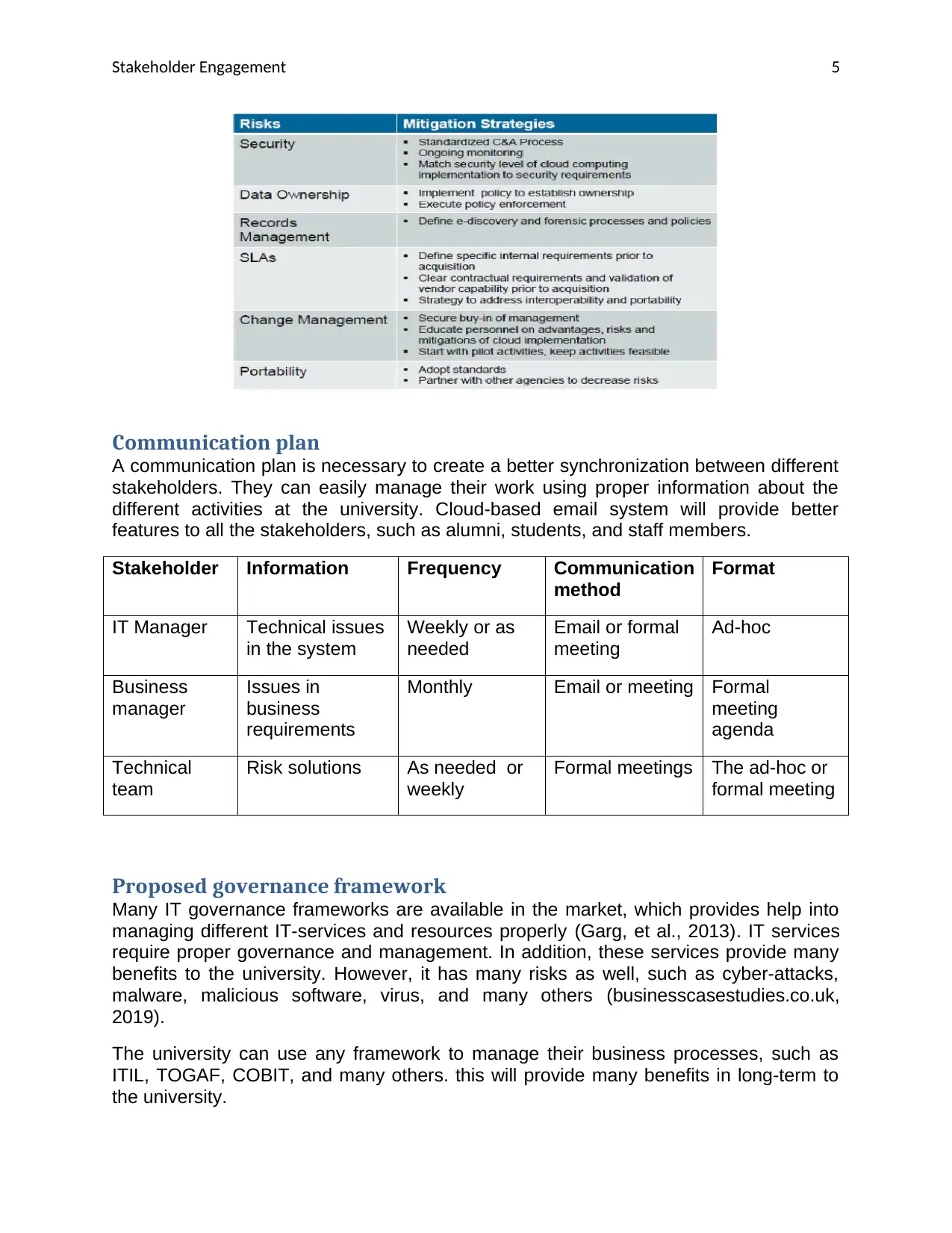
Stakeholder Engagement 5
Communication plan
A communication plan is necessary to create a better synchronization between different
stakeholders. They can easily manage their work using proper information about the
different activities at the university. Cloud-based email system will provide better
features to all the stakeholders, such as alumni, students, and staff members.
Stakeholder Information Frequency Communication
method
Format
IT Manager Technical issues
in the system
Weekly or as
needed
Email or formal
meeting
Ad-hoc
Business
manager
Issues in
business
requirements
Monthly Email or meeting Formal
meeting
agenda
Technical
team
Risk solutions As needed or
weekly
Formal meetings The ad-hoc or
formal meeting
Proposed governance framework
Many IT governance frameworks are available in the market, which provides help into
managing different IT-services and resources properly (Garg, et al., 2013). IT services
require proper governance and management. In addition, these services provide many
benefits to the university. However, it has many risks as well, such as cyber-attacks,
malware, malicious software, virus, and many others (businesscasestudies.co.uk,
2019).
The university can use any framework to manage their business processes, such as
ITIL, TOGAF, COBIT, and many others. this will provide many benefits in long-term to
the university.
Communication plan
A communication plan is necessary to create a better synchronization between different
stakeholders. They can easily manage their work using proper information about the
different activities at the university. Cloud-based email system will provide better
features to all the stakeholders, such as alumni, students, and staff members.
Stakeholder Information Frequency Communication
method
Format
IT Manager Technical issues
in the system
Weekly or as
needed
Email or formal
meeting
Ad-hoc
Business
manager
Issues in
business
requirements
Monthly Email or meeting Formal
meeting
agenda
Technical
team
Risk solutions As needed or
weekly
Formal meetings The ad-hoc or
formal meeting
Proposed governance framework
Many IT governance frameworks are available in the market, which provides help into
managing different IT-services and resources properly (Garg, et al., 2013). IT services
require proper governance and management. In addition, these services provide many
benefits to the university. However, it has many risks as well, such as cyber-attacks,
malware, malicious software, virus, and many others (businesscasestudies.co.uk,
2019).
The university can use any framework to manage their business processes, such as
ITIL, TOGAF, COBIT, and many others. this will provide many benefits in long-term to
the university.
⊘ This is a preview!⊘
Do you want full access?
Subscribe today to unlock all pages.

Trusted by 1+ million students worldwide

Stakeholder Engagement 6
Vendor analysis
It is necessary to identify that vendor provides benefits for the university, but they also
fulfill all the requirements of university and stakeholders (Opara-Martins, et al., 2016). It
should have a high quality of services and maintenance facility (cucasia.com, 2019).
In addition, the university can take help from a consultant to suggest them for cloud-
based email system based on their business requirements, such as collaboration and
governance. It is a suitable and feasible way for university.
Source: (Evans, 2019)
Strategies for stakeholders engagement
The university should consult with its stakeholders for implementation of this facility in
their premises to know about advantage and threats for the system. It is necessary to
step to identify proper feedback of stakeholders on the implementation process of this
feature (Durcevic, 2019).
There are different stakeholders in university, such as students, staff members,
management, and others. In addition, the university has IT infrastructure for different
purposes. Therefore, the university is only required cloud-based email system, which
can easily implement in the university, without having large changes in the IT
infrastructure because of cloud-based services (Agnete Alsos, et al., 2011).
Vendor analysis
It is necessary to identify that vendor provides benefits for the university, but they also
fulfill all the requirements of university and stakeholders (Opara-Martins, et al., 2016). It
should have a high quality of services and maintenance facility (cucasia.com, 2019).
In addition, the university can take help from a consultant to suggest them for cloud-
based email system based on their business requirements, such as collaboration and
governance. It is a suitable and feasible way for university.
Source: (Evans, 2019)
Strategies for stakeholders engagement
The university should consult with its stakeholders for implementation of this facility in
their premises to know about advantage and threats for the system. It is necessary to
step to identify proper feedback of stakeholders on the implementation process of this
feature (Durcevic, 2019).
There are different stakeholders in university, such as students, staff members,
management, and others. In addition, the university has IT infrastructure for different
purposes. Therefore, the university is only required cloud-based email system, which
can easily implement in the university, without having large changes in the IT
infrastructure because of cloud-based services (Agnete Alsos, et al., 2011).
Paraphrase This Document
Need a fresh take? Get an instant paraphrase of this document with our AI Paraphraser
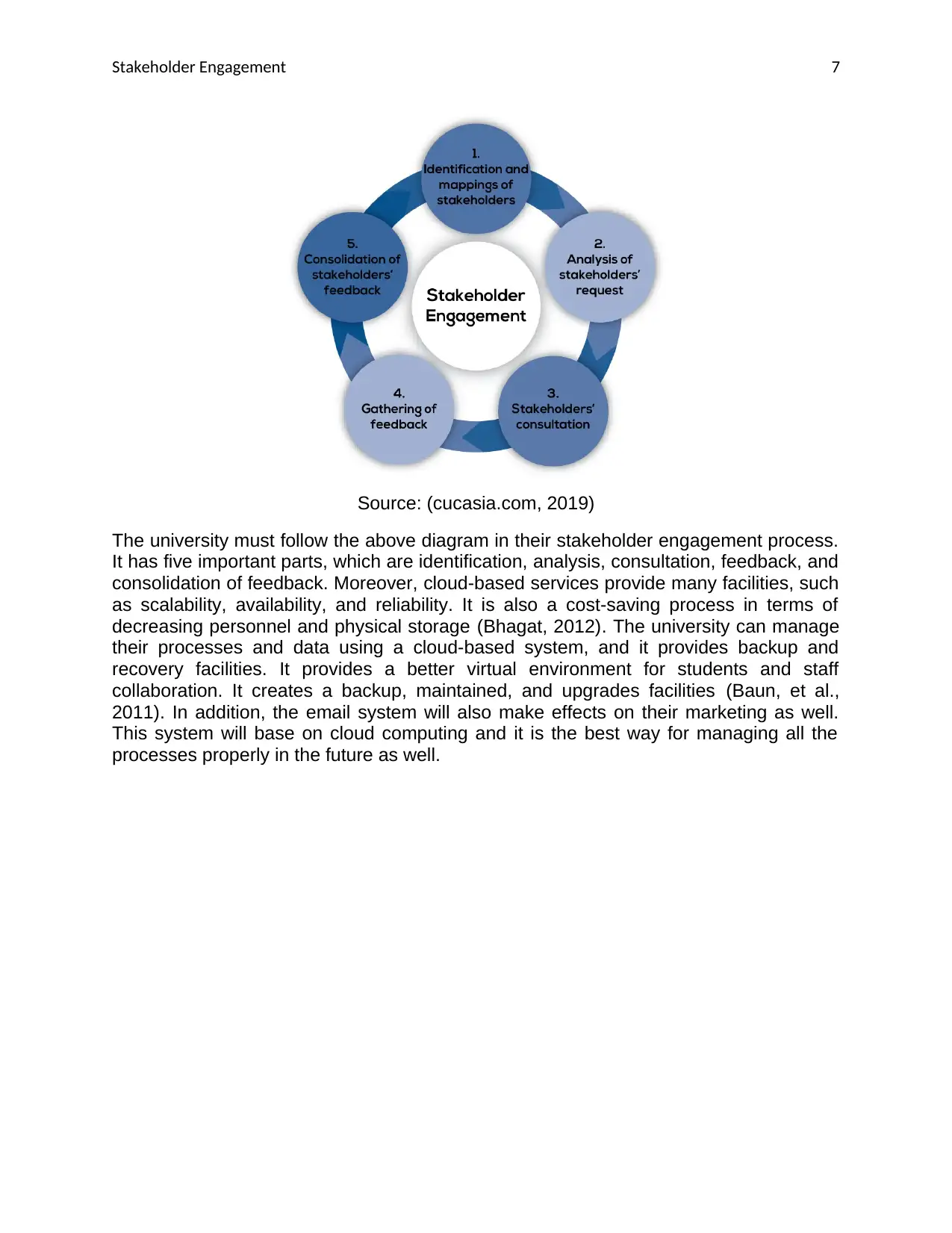
Stakeholder Engagement 7
Source: (cucasia.com, 2019)
The university must follow the above diagram in their stakeholder engagement process.
It has five important parts, which are identification, analysis, consultation, feedback, and
consolidation of feedback. Moreover, cloud-based services provide many facilities, such
as scalability, availability, and reliability. It is also a cost-saving process in terms of
decreasing personnel and physical storage (Bhagat, 2012). The university can manage
their processes and data using a cloud-based system, and it provides backup and
recovery facilities. It provides a better virtual environment for students and staff
collaboration. It creates a backup, maintained, and upgrades facilities (Baun, et al.,
2011). In addition, the email system will also make effects on their marketing as well.
This system will base on cloud computing and it is the best way for managing all the
processes properly in the future as well.
Source: (cucasia.com, 2019)
The university must follow the above diagram in their stakeholder engagement process.
It has five important parts, which are identification, analysis, consultation, feedback, and
consolidation of feedback. Moreover, cloud-based services provide many facilities, such
as scalability, availability, and reliability. It is also a cost-saving process in terms of
decreasing personnel and physical storage (Bhagat, 2012). The university can manage
their processes and data using a cloud-based system, and it provides backup and
recovery facilities. It provides a better virtual environment for students and staff
collaboration. It creates a backup, maintained, and upgrades facilities (Baun, et al.,
2011). In addition, the email system will also make effects on their marketing as well.
This system will base on cloud computing and it is the best way for managing all the
processes properly in the future as well.
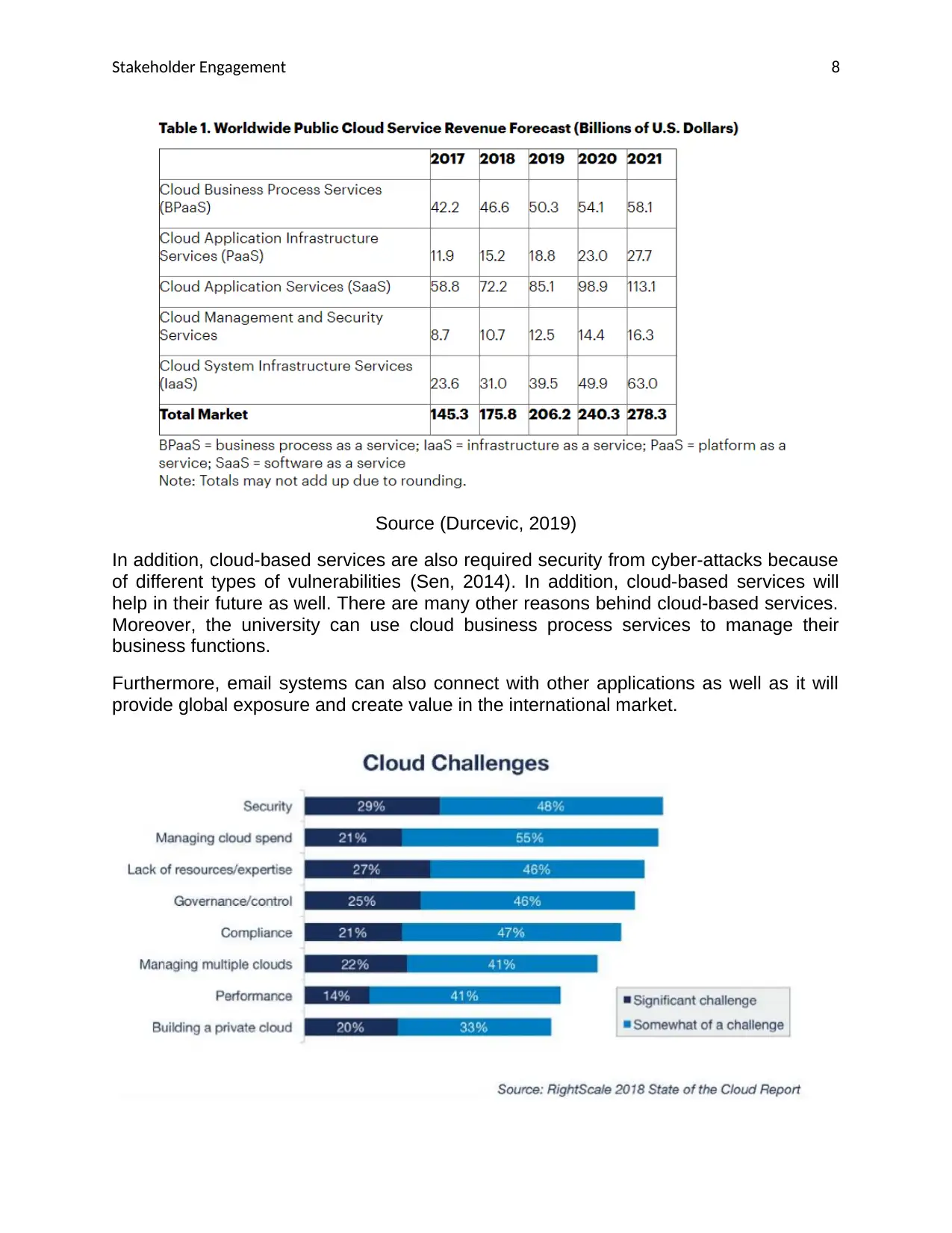
Stakeholder Engagement 8
Source (Durcevic, 2019)
In addition, cloud-based services are also required security from cyber-attacks because
of different types of vulnerabilities (Sen, 2014). In addition, cloud-based services will
help in their future as well. There are many other reasons behind cloud-based services.
Moreover, the university can use cloud business process services to manage their
business functions.
Furthermore, email systems can also connect with other applications as well as it will
provide global exposure and create value in the international market.
Source (Durcevic, 2019)
In addition, cloud-based services are also required security from cyber-attacks because
of different types of vulnerabilities (Sen, 2014). In addition, cloud-based services will
help in their future as well. There are many other reasons behind cloud-based services.
Moreover, the university can use cloud business process services to manage their
business functions.
Furthermore, email systems can also connect with other applications as well as it will
provide global exposure and create value in the international market.
⊘ This is a preview!⊘
Do you want full access?
Subscribe today to unlock all pages.

Trusted by 1+ million students worldwide
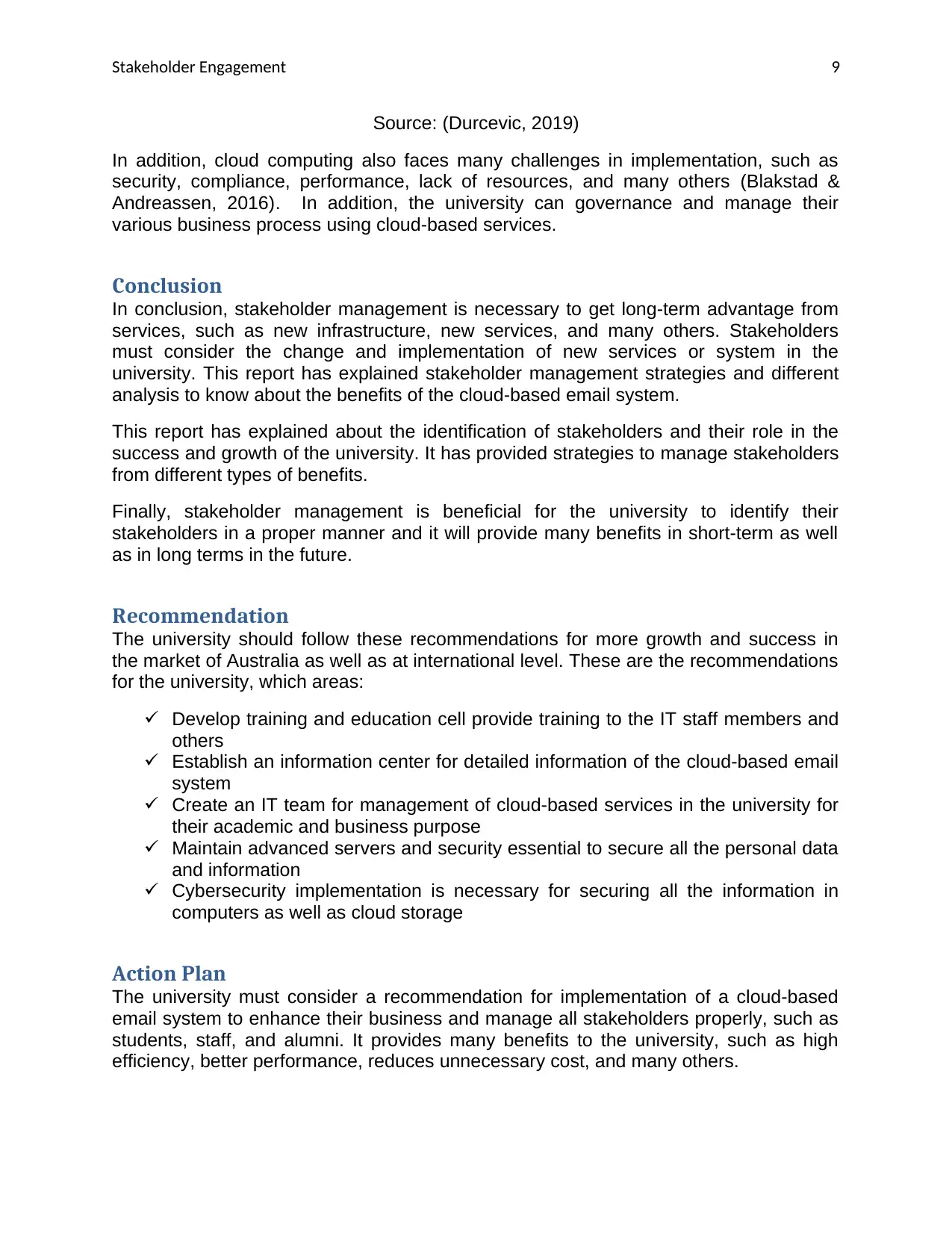
Stakeholder Engagement 9
Source: (Durcevic, 2019)
In addition, cloud computing also faces many challenges in implementation, such as
security, compliance, performance, lack of resources, and many others (Blakstad &
Andreassen, 2016). In addition, the university can governance and manage their
various business process using cloud-based services.
Conclusion
In conclusion, stakeholder management is necessary to get long-term advantage from
services, such as new infrastructure, new services, and many others. Stakeholders
must consider the change and implementation of new services or system in the
university. This report has explained stakeholder management strategies and different
analysis to know about the benefits of the cloud-based email system.
This report has explained about the identification of stakeholders and their role in the
success and growth of the university. It has provided strategies to manage stakeholders
from different types of benefits.
Finally, stakeholder management is beneficial for the university to identify their
stakeholders in a proper manner and it will provide many benefits in short-term as well
as in long terms in the future.
Recommendation
The university should follow these recommendations for more growth and success in
the market of Australia as well as at international level. These are the recommendations
for the university, which areas:
Develop training and education cell provide training to the IT staff members and
others
Establish an information center for detailed information of the cloud-based email
system
Create an IT team for management of cloud-based services in the university for
their academic and business purpose
Maintain advanced servers and security essential to secure all the personal data
and information
Cybersecurity implementation is necessary for securing all the information in
computers as well as cloud storage
Action Plan
The university must consider a recommendation for implementation of a cloud-based
email system to enhance their business and manage all stakeholders properly, such as
students, staff, and alumni. It provides many benefits to the university, such as high
efficiency, better performance, reduces unnecessary cost, and many others.
Source: (Durcevic, 2019)
In addition, cloud computing also faces many challenges in implementation, such as
security, compliance, performance, lack of resources, and many others (Blakstad &
Andreassen, 2016). In addition, the university can governance and manage their
various business process using cloud-based services.
Conclusion
In conclusion, stakeholder management is necessary to get long-term advantage from
services, such as new infrastructure, new services, and many others. Stakeholders
must consider the change and implementation of new services or system in the
university. This report has explained stakeholder management strategies and different
analysis to know about the benefits of the cloud-based email system.
This report has explained about the identification of stakeholders and their role in the
success and growth of the university. It has provided strategies to manage stakeholders
from different types of benefits.
Finally, stakeholder management is beneficial for the university to identify their
stakeholders in a proper manner and it will provide many benefits in short-term as well
as in long terms in the future.
Recommendation
The university should follow these recommendations for more growth and success in
the market of Australia as well as at international level. These are the recommendations
for the university, which areas:
Develop training and education cell provide training to the IT staff members and
others
Establish an information center for detailed information of the cloud-based email
system
Create an IT team for management of cloud-based services in the university for
their academic and business purpose
Maintain advanced servers and security essential to secure all the personal data
and information
Cybersecurity implementation is necessary for securing all the information in
computers as well as cloud storage
Action Plan
The university must consider a recommendation for implementation of a cloud-based
email system to enhance their business and manage all stakeholders properly, such as
students, staff, and alumni. It provides many benefits to the university, such as high
efficiency, better performance, reduces unnecessary cost, and many others.
Paraphrase This Document
Need a fresh take? Get an instant paraphrase of this document with our AI Paraphraser

Stakeholder Engagement 10
The university should implement an email system in the next six months, as it has many
benefits for the university. It will increase their performance of work and provide a
competitive advantage as well. The university should analysis vendors in 2 to 3 weeks
and chooses an appropriate vendor based on their requirements, such as an email
system. It will take minimum of six months in implementation and after that testing will
be completed, based on different perspectives.
References
Agnete Alsos, . G., Hytti, U. & Ljunggren, E., 2011. Stakeholder theory approach to
technology incubators. International Journal of Entrepreneurial Behavior & Research,
17(6), pp. 607-625.
Baun, C., Kunze, M., Nimis, J. & Tai, S., 2011. Cloud computing: Web-based dynamic
IT services.. 1 ed. London: Springer Science & Business Media..
Bhagat, . B. C., 2012. Cloud computing governance, cyber security, risk, and
compliance business rules system and method. U. S., Patent No. 13/016,999.
Blakstad, K. . M. & Andreassen, M., 2016. Security in Cloud Computing: A Security
Assessment of Cloud Computing Providers for an Online Receipt Storage. [Online]
Available at: https://brage.bibsys.no/xmlui/handle/11250/253189
[Accessed 21 February 2019].
businesscasestudies.co.uk, 2019. Stakeholders as partners. [Online]
Available at:
http://businesscasestudies.co.uk/bt/stakeholders-as-partners/introduction.html
[Accessed 9 June 2019].
The university should implement an email system in the next six months, as it has many
benefits for the university. It will increase their performance of work and provide a
competitive advantage as well. The university should analysis vendors in 2 to 3 weeks
and chooses an appropriate vendor based on their requirements, such as an email
system. It will take minimum of six months in implementation and after that testing will
be completed, based on different perspectives.
References
Agnete Alsos, . G., Hytti, U. & Ljunggren, E., 2011. Stakeholder theory approach to
technology incubators. International Journal of Entrepreneurial Behavior & Research,
17(6), pp. 607-625.
Baun, C., Kunze, M., Nimis, J. & Tai, S., 2011. Cloud computing: Web-based dynamic
IT services.. 1 ed. London: Springer Science & Business Media..
Bhagat, . B. C., 2012. Cloud computing governance, cyber security, risk, and
compliance business rules system and method. U. S., Patent No. 13/016,999.
Blakstad, K. . M. & Andreassen, M., 2016. Security in Cloud Computing: A Security
Assessment of Cloud Computing Providers for an Online Receipt Storage. [Online]
Available at: https://brage.bibsys.no/xmlui/handle/11250/253189
[Accessed 21 February 2019].
businesscasestudies.co.uk, 2019. Stakeholders as partners. [Online]
Available at:
http://businesscasestudies.co.uk/bt/stakeholders-as-partners/introduction.html
[Accessed 9 June 2019].

Stakeholder Engagement 11
Chen, D. & Zhao, H., 2012. Data security and privacy protection issues in cloud
computing. International Conference on Computer Science and Electronics
Engineering, 1(1), pp. 647-651.
cucasia.com, 2019. Stakeholder Engagement. [Online]
Available at: https://www.cucasia.com/about/stakeholder-engagement/
[Accessed 14 June 2019].
Durcevic, S., 2019. The datapine Blog. [Online]
Available at: https://www.datapine.com/blog/cloud-computing-risks-and-challenges/
[Accessed 14 June 2019].
Evans, B., 2019. The Top 10 Cloud Vendors by Revenue: Splitting a $120-Billion Pie.
[Online]
Available at: https://cloudwars.co/top-10-cloud-vendors-revenue-2019/
[Accessed 17 June 2019].
Garg, S. . K., Versteeg, S. & Buyya, R., 2013. A framework for ranking of cloud
computing services. Future Generation Computer Systems, 29(4), pp. 1012-1023.
Opara-Martins, J., Sahandi, R. & Tian, F., 2016. Critical analysis of vendor lock-in and
its impact on cloud computing migration: a business perspective. Journal of Cloud
Computing, 5(1), p. 4.
Sen, J., 2014. Security and privacy issues in cloud computing.. In: In Architectures and
protocols for secure information technology infrastructures. USA: IGI Global, pp. 1-45.
Takabi, H., Joshi, J. B. & Ahn, G. J., 2010. Security and privacy challenges in cloud
computing environments.. IEEE Security & Privacy, 6(1), pp. 24-31.
Chen, D. & Zhao, H., 2012. Data security and privacy protection issues in cloud
computing. International Conference on Computer Science and Electronics
Engineering, 1(1), pp. 647-651.
cucasia.com, 2019. Stakeholder Engagement. [Online]
Available at: https://www.cucasia.com/about/stakeholder-engagement/
[Accessed 14 June 2019].
Durcevic, S., 2019. The datapine Blog. [Online]
Available at: https://www.datapine.com/blog/cloud-computing-risks-and-challenges/
[Accessed 14 June 2019].
Evans, B., 2019. The Top 10 Cloud Vendors by Revenue: Splitting a $120-Billion Pie.
[Online]
Available at: https://cloudwars.co/top-10-cloud-vendors-revenue-2019/
[Accessed 17 June 2019].
Garg, S. . K., Versteeg, S. & Buyya, R., 2013. A framework for ranking of cloud
computing services. Future Generation Computer Systems, 29(4), pp. 1012-1023.
Opara-Martins, J., Sahandi, R. & Tian, F., 2016. Critical analysis of vendor lock-in and
its impact on cloud computing migration: a business perspective. Journal of Cloud
Computing, 5(1), p. 4.
Sen, J., 2014. Security and privacy issues in cloud computing.. In: In Architectures and
protocols for secure information technology infrastructures. USA: IGI Global, pp. 1-45.
Takabi, H., Joshi, J. B. & Ahn, G. J., 2010. Security and privacy challenges in cloud
computing environments.. IEEE Security & Privacy, 6(1), pp. 24-31.
⊘ This is a preview!⊘
Do you want full access?
Subscribe today to unlock all pages.

Trusted by 1+ million students worldwide
1 out of 12
Related Documents
Your All-in-One AI-Powered Toolkit for Academic Success.
+13062052269
info@desklib.com
Available 24*7 on WhatsApp / Email
![[object Object]](/_next/static/media/star-bottom.7253800d.svg)
Unlock your academic potential
Copyright © 2020–2025 A2Z Services. All Rights Reserved. Developed and managed by ZUCOL.





